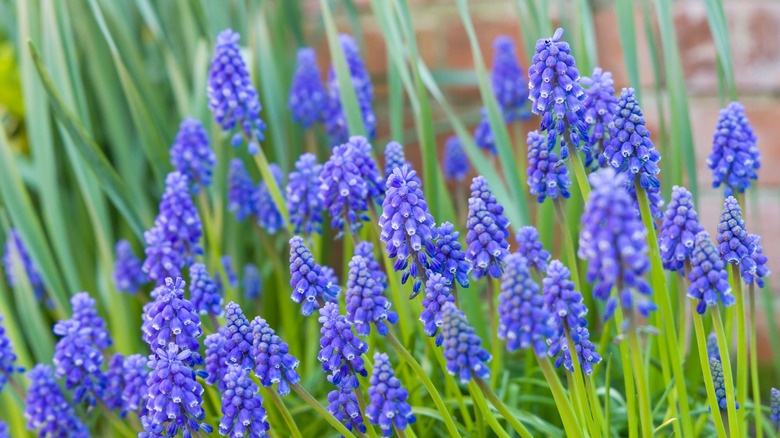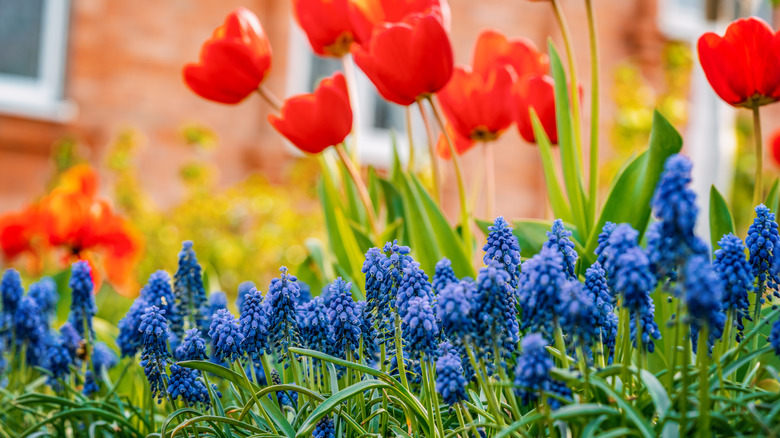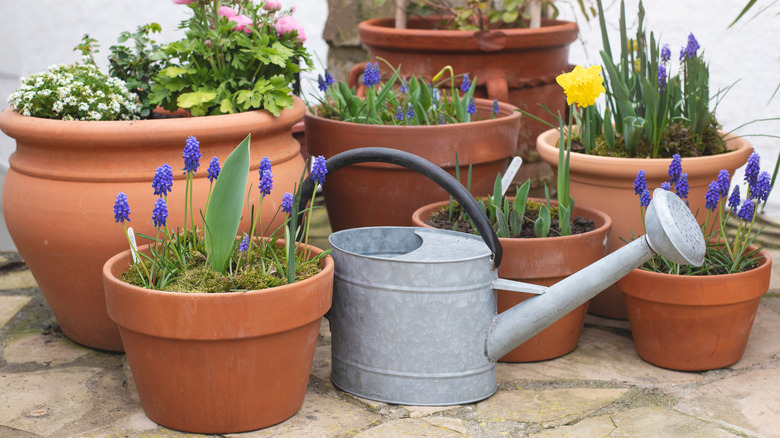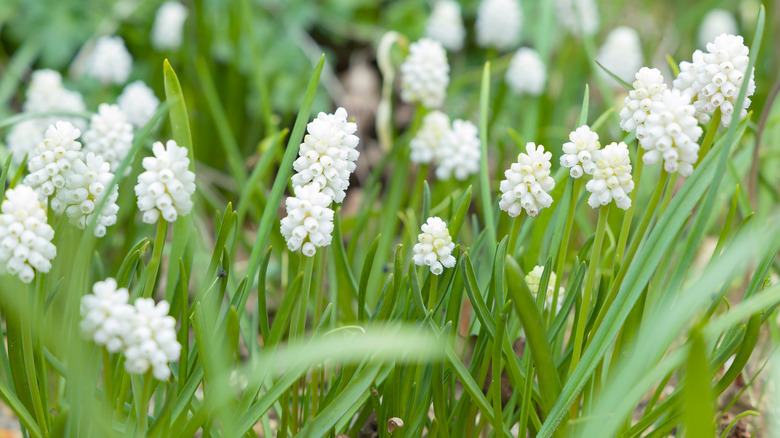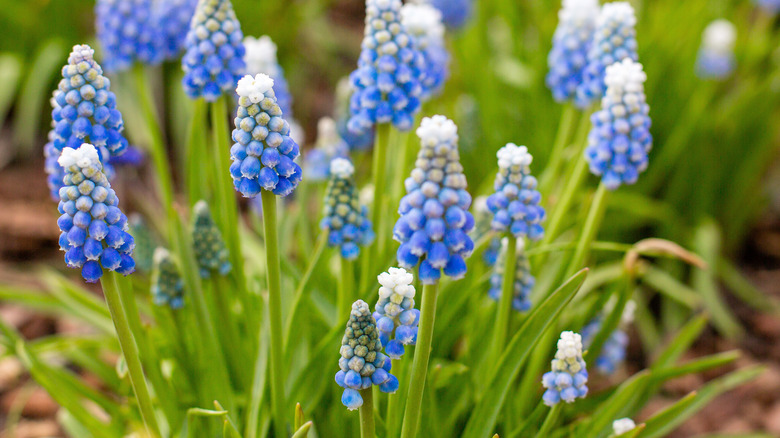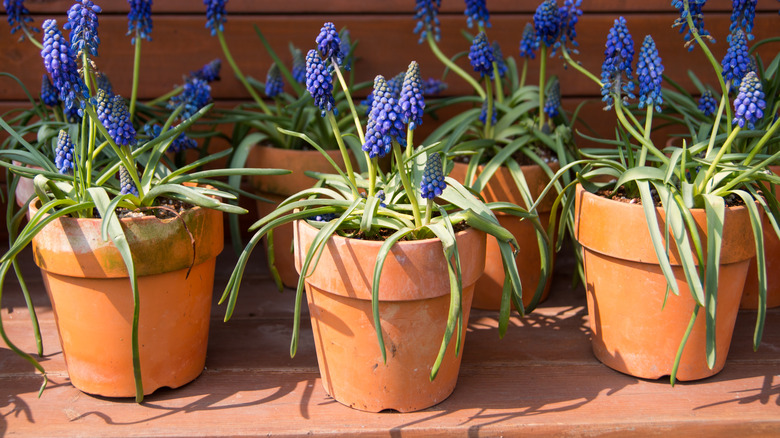How To Care For Muscari Flowers
Muscari flowers, or muscari armeniacum, are beautiful, hardy, and easy-to-care-for flowers that bring bright color and fragrance to any garden. Growing from bulbs and reaching heights of 6 to 9 inches, muscari is a spring perennial flower, blooming each year in April or May, as per The Spruce. Their blooms range in color from blue to white, and they can even be seen in shades of pink and yellow. Each bloom also features a cluster of flowers resembling a bunch of grapes, giving this flower the nickname "grape hyacinth."
Muscari flowers are native to southeastern Europe, and dozens of species of these flowers are grown today, according to the University of Wisconsin-Madison. They are very low-maintenance, making them an excellent flower for beginner gardeners. They also produce lots of foliage in the form of long, sharp leaves well into the summer and fall, which makes them a great addition to your garden even after their blooms fade. If you're looking for a sweetly fragranced and brightly colored perennial flower, look no further than muscari flowers.
How to use muscari flowers in your garden
The deep blue colors of muscari flowers are a beautiful addition to any perennial garden. Muscari blooms last a few weeks and are sure to make a statement in your garden with their bright colors and uniquely shaped flowers. Their smaller size makes them great to pair with larger flowers and plants. For example, muscari look beautiful when planted in borders in front of taller perennial spring-blooming flowers, such as daffodils and tulips, as per High Country Gardens.
Because muscari are tough flowers, they can be planted just about anywhere in your garden. Consider planting muscari in a rock garden or spreading the bulbs out for a more whimsical cottage-style look. You can also plant these flowers along pathways for a pop of color. Muscari thrive in pots and containers as well, which allows you to move them around your yard for a unique garden design.
How to grow muscari flowers
Like many other spring-blooming perennials, muscari flowers are primarily grown from bulbs. Gardeners' World explains how to grow and propagate them. It is best to plant muscari bulbs before the first frost in the fall. The bulbs should be planted no more than a few inches deep and spaced a few inches apart. They also aren't super fussy about their proximity to other bulbs. In fact, it is recommended to plant muscari bulbs close to one another in groups of up to 25 bulbs, depending on the size of your container or planting area, according to Gardener's Path. Plant the bulbs in well-draining soil and water them, but be careful not to overwater.
Since muscari flowers grow primarily from bulbs, they can be propagated through division. Dividing muscari flowers is an easy process and allows you to increase the number of flowers you have throughout your garden. Your muscari flowers need to be divided every three to five years. The best time to do this is during the summer when the plants are done producing flowers. The first step to dividing your flowers is to gently dig up the plant and separate the clumps of roots. You may notice that some offshoots and bulbs are larger than others, but all of them should produce blooms if replanted elsewhere in your garden.
How to care for muscari flowers
Once established, muscari flowers are a very low-maintenance plant that requires little care and attention. These flowers do best in full sunlight, although they can also grow in partial sunlight. They also don't need excessive watering and can usually thrive with just rainfall unless there is a drought. You won't need to supply fertilizer throughout the year, but planting muscari with organic matter, such as manure or compost, may benefit the soil's drainage.
The primary maintenance that muscari flowers require is dividing the bulbs every few years, per Longfield Gardens. As discussed above, these flowers grow from bulbs, and if they aren't divided every few years, they can become overcrowded and might not bloom as easily. The foliage on muscari flowers also needs to be removed when it begins to brown after the blooms have faded. The plants will produce new foliage in the fall, which will allow them to store energy in preparation for the following year's bloom.
Muscari flower varieties
Although muscari flowers are often referred to as "grape hyacinths," they are not related to hyacinths. Muscari are their own genus of flowers with over 30 species, all of which bloom in the spring with beautiful, fragrant flowers. Gardenia discusses a few varieties of muscari flowers.
-
Muscari armeniacum 'Valerie Finnis': Unlike ordinary muscari flowers, this variety has blooms that are light lavender in color.
-
Muscari aucheri 'Ocean Magic': Named for their resemblance to the ocean, these unique blooms are dark purple/blue at the bottom and fade into light blue or white toward the top.
-
Muscari azureum 'Album': This stark-white variety of muscari flowers stands out against the colorful blooms of other spring flowers.
-
Muscari latifolium: With blooms that are dark purple on the bottom and lavender at the top, these muscari flowers make a statement in any garden.
-
Muscari macrocarpum 'Golden Fragrance': In contrast with the purple varieties of many muscari flowers, 'Golden Fragrance' has bright, yellow-colored blooms with hints of purple at the top.
How to repot muscari flowers
Muscari flowers grow beautifully when planted in both the ground and in containers and pots. Because muscari grow from bulbs, they need to be divided and moved around your garden every few years. Since these flowers are hardy, they can also be repotted even when it isn't time for division. You can replant your muscari during the fall, summer, or spring, and they will survive the move and continue blooming.
To repot your muscari, Gardener's Path recommends you first prepare the soil in the new pot. The soil should be well-draining. If it isn't, adding some organic matter or sand will help. Dig a large shallow hole in the new pot of soil. Then gently dig up your muscari from the original pot and divide the bulbs if needed. Plant the bulbs in the new pot, covering them with soil and watering them. Note that you can plant several bulbs together in a pot; for example, 8 to 12 bulbs will fit in a 6-inch-wide by 6-inch-deep pot.
